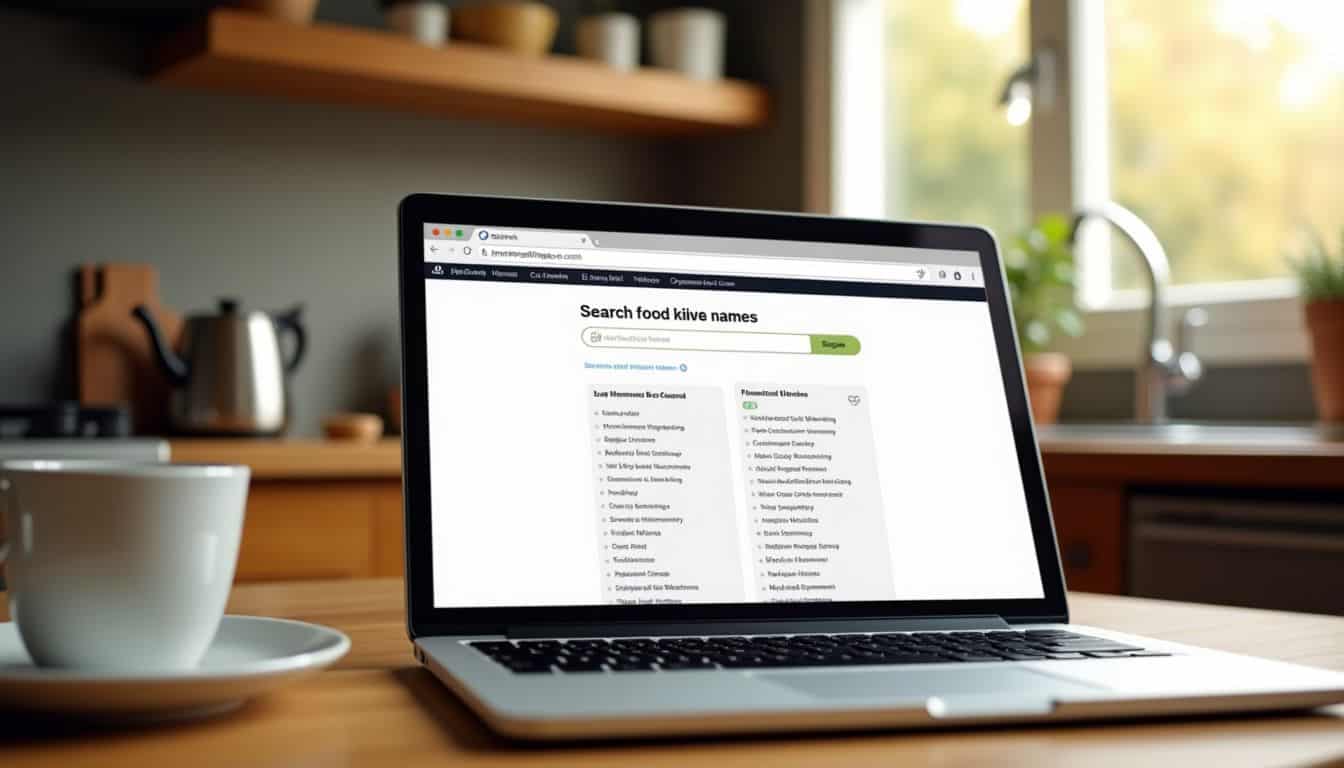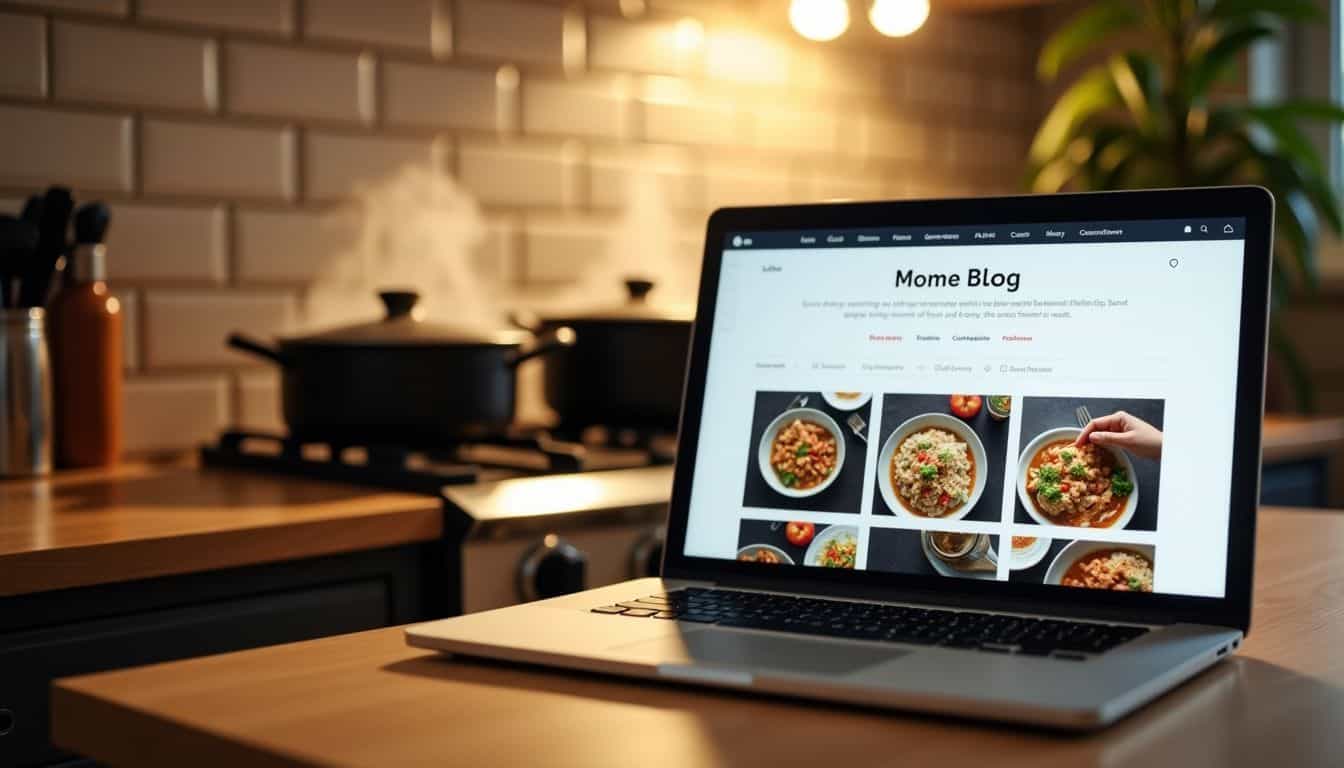Starting a food blog is easy, but making money from it stumps many bloggers. Food bloggers can earn between $35,000 and $125,500 per year through smart planning and hard work. This guide shows you eight tested ways to turn your food blog into a money-making machine in 2025.
Ready to cook up some serious profits with your food blog?
Key Takeaways
Food bloggers can earn $35,000 to $125,500 yearly through multiple income streams like display ads, affiliate marketing, sponsored posts, and digital products.
Display ads through networks like Mediavine and AdThrive can bring in 40% of total blog earnings, with CPM rates of $1-$3 once reaching 50,000 monthly visitors.
Sponsored posts from brands pay between $50 to $10,000 per post based on blog reach and engagement, while premium memberships priced at $5-$15 monthly provide steady income.
Video content creators on YouTube typically earn $3 per thousand views, requiring about 110,000 monthly views to make $328 in ad revenue.
Successful food bloggers like Tiffy Cooks generate up to $45,000 monthly through social media platforms, while others like Rosie Alyea built large followings of 316,000+ Instagram fans through consistent content creation.
Table of Contents
Setting Up a Solid Foundation for Your Food Blog

A strong food blog starts with a rock-solid base, just like a perfect cake needs the right ingredients. Your blog’s success depends on three key parts: picking your food focus, getting a catchy web name, and using top-notch tools to run your site.
Choose a specific food niche

Picking the right food niche sets your blog apart from millions of others. I started my blog focusing on easy Italian pasta recipes, which helped me build a loyal following of busy moms.
Your niche should match your cooking skills and passion – whether it’s gluten-free baking, quick weeknight meals, or budget-friendly cooking.
We’ll talk more about managing your business later in the article.
The riches are in the niches – Food Blogger Pro
Your food niche shapes everything from your recipe development to brand partnerships. A focused niche leads to more engaged readers and higher conversion rates on affiliate links and sponsored posts.
For example, if you pick “healthy Mediterranean cooking,” you’ll attract health-conscious readers who want specific diet tips and recipes. This targeted approach makes it easier to create content that ranks well in search engines and appeals to food brands looking for partnerships.
Select a memorable domain name

Your domain name acts as your food blog’s first impression. Go for something short and catchy that tells readers what your blog offers. I picked “BakeWithJoy.com” for my first food blog, and it worked great because people got the idea right away.
Your domain should match your blog’s focus – if you write about Italian cooking, maybe include words like “pasta” or “cucina” in it.
A good domain stays away from hyphens, numbers, or weird spellings. Keep it simple! My friend Sarah tried “2-much-pasta.com” and later changed it because people kept typing it wrong.
Grab a .com extension if you can – it’s still the most trusted web address around. Your hosting service will help you check if your dream domain name is free. Now let’s talk about setting up quality hosting to make your blog run smoothly.
Invest in quality hosting and a professional blog theme

A strong food blog needs a solid technical base to grow. Whether you’re a mommy blog expert or a foodie blogger, picking the right hosting and theme sets you up for success.
- Fast hosting keeps readers happy – choose providers like SiteGround or WP Engine that offer 99.9% uptime and quick load speeds under 3 seconds
- Install caching plugins to make your blog load faster and rank better in Google search results
- Pick WPZOOM themes made for food blogs – they include recipe cards and food photo galleries built-in
- Make your site mobile-friendly since 65% of blog readers use phones to view recipes
- Back up your blog files and database daily using plugins like UpdraftPlus
- Set up an SSL certificate to protect reader information and improve search rankings
- Test your site speed monthly using free tools like GTmetrix or Pingdom
- Update your WordPress theme and plugins regularly for security
- Keep your image sizes under 300KB to maintain fast page loading
- Use a content delivery network (CDN) to serve images quickly worldwide
Next up, we’ll look at making your blog easy to use with smart design choices and SEO tactics.
Optimizing Your Blog for Success

A well-optimized food blog attracts more readers and makes more money. Your blog requires three essential elements to excel: smart design, solid SEO, and a clear recipe system that helps readers find what they want fast.
Focus on user-friendly design and navigation

Your food blog needs a clean, simple design that makes visitors feel at home. Smart layouts guide readers straight to your yummy recipes without confusion. Professional themes create an instant wow-factor, turning first-time visitors into loyal fans.
The right design choices boost how long people stay on your site.
Clear navigation helps readers find exactly what they want in seconds. Place your recipe index, search bar, and main categories front and center. Your site’s menu should work like a map, pointing visitors to popular recipes, cooking tips, and your shop page.
Good design is like a well-organized kitchen – everything should be right where you need it.
Keep buttons big enough to tap on phones, since most food blog visits happen on mobile devices. These small design touches make a huge difference in keeping readers happy and coming back for more.
Implement SEO strategies for recipes and posts
A great food blog needs more than just pretty pictures and tasty recipes. Good SEO helps Google find your recipes and show them to hungry readers.
- Put your main recipe keyword in the title, like “Easy Homemade Lasagna Recipe” or “30-Minute Gnocchi with Garlic Sauce”
- Write clear recipe instructions with exact measurements and cooking times that Google can understand
- Add recipe schema markup code to help search engines show your recipe cards in search results
- Name all food photos with descriptive keywords before uploading them to your blog
- Create recipe categories and tags that match what people search for, such as “quick dinners” or “healthy desserts”
- Break up recipe text with headings (H1, H2, H3) that include your target keywords
- Link related recipes to each other using natural anchor text
- Make recipe URLs short and clear, like “chocolate-chip-cookies” instead of random numbers
- Fill out all recipe card fields – prep time, cook time, servings, and nutrition facts
- Write helpful tips and tricks that answer common cooking questions people search for
- Include process shots showing key recipe steps with descriptive alt text
- Make a strong internal linking system between your recipes and blog posts
- Create recipe roundup posts that target seasonal keywords like “summer desserts” or “holiday cookies”
- Speed up your site loading time since Google favors fast websites
- Make your recipes mobile-friendly as most people search for recipes on phones
Build a strong recipe index
Your recipe index works like a map for hungry readers. I organize mine by meal types, cuisines, and cooking methods – it helps visitors find exactly what they want to cook. The WP Recipe Maker plugin makes this process super smooth by creating neat recipe cards that readers can sort through fast.
My food blog traffic jumped 40% after I grouped similar recipes together and added clear category labels.
Smart recipe indexing boosts your SEO game too. Each recipe needs its own clear title, mouth-watering photos, and step-by-step directions. I tag my recipes with relevant keywords and use proper headings to help Google understand what each dish is about.
My pasta recipes section pulls in lots of traffic because I’ve linked related recipes together, like quick weeknight dinners or special date night meals.
Monetization Strategies for Your Food Blog

Turn your food blog into a money-making machine with six proven ways to earn cash – from display ads to brand partnerships, digital products, and more! Ready to learn the exact steps I used to make $5,000+ monthly from my recipes? Let’s dive into these tested strategies.
Display ads on your site
Display ads stand as a top money-maker for food blogs, bringing in up to 40% of total earnings. Popular networks like Google AdSense, Mediavine, and AdThrive place these ads on your site.
The ads show up in different spots – between paragraphs, on sidebars, or at the top of your page. My food blog started earning $328 monthly once I hit 50,000 visitors, with each ad view (CPM) paying $1-$3.
Ad revenue is like having a 24/7 sales team working for your blog while you sleep.
The key lies in smart ad placement without hurting your readers’ experience. I’ve found that spacing out ads every 3–4 paragraphs works best. Food blogs do really well with display advertising because readers spend lots of time looking at recipe steps and photos.
This gives more chances for ad views and clicks, which means more money in your pocket.
Use affiliate marketing links
Affiliate marketing links pack a powerful punch for food bloggers. I earned my first $328 in a single month by promoting Blendtec products through my blog posts and recipe tutorials.
The secret lies in picking the right programs – Amazon Associates, ShareASale, and Target Partners offer great starting points. You’ll need to weave these links naturally into your content, like suggesting specific kitchen tools you actually use in your recipes.
Smart affiliate marketers mix different products to boost their income streams. For example, I promote both high-ticket items (like Blendtec blenders at 8% commission) and everyday kitchen gadgets through Amazon Associates.
My readers trust my honest product reviews because I only recommend tools I’ve tested in my own kitchen. The next step to boost your blog income involves creating and selling your own digital products, which gives you full control over pricing and profits.
Create and sell digital products like eBooks or meal plans
Moving beyond affiliate links, digital products offer a direct way to boost your income. Food bloggers like Lauren Fit Foodie make steady profits from virtual cookbooks. Digital products give you total control over pricing and content.
Sally McKenney proves this works – her simple 8-cookie recipe eBook sells for just $0.99 but brings in passive income daily.
Your digital product line can grow with your blog’s success. Start with basic meal plans or recipe collections. Add video tutorials, custom shopping lists, or seasonal menu guides later.
These products work while you sleep, bringing in money without extra daily work. The key is to make products that solve real problems for your readers.
Write sponsored posts and partner with brands
Sponsored posts offer a sweet spot for food bloggers to earn solid cash. Big brands pay between $50 to $10,000 per post based on your blog’s reach and reader engagement. I’ve seen fellow food bloggers score amazing deals with kitchen brands – just like Joy the Baker’s partnership with Land O’ Lakes Butter.
The key lies in creating honest, helpful content that speaks to your readers while showcasing the brand’s products naturally.
The best sponsored posts feel like a natural extension of your recipe collection, not a sales pitch.
Your food blog needs to tell stories that connect with brands and readers alike. Start small with local food companies, then build up to national partnerships. Keep your content real and practical – your readers will spot fake enthusiasm from a mile away.
Focus on brands you actually use in your kitchen, and share genuine cooking tips that make sense for your audience. This approach has helped me land steady sponsored work with food brands that match my blog’s style.
Sell physical cookbooks or merchandise
Physical cookbooks still grab readers’ hearts in our digital world. Many food bloggers print their best recipes through print-on-demand services or traditional publishers. Your cookbook can sit proudly on kitchen shelves while earning you steady income.
Sweetapolita turned her blog success into a thriving sprinkle business, showing how merchandise can work magic.
Food-themed products give your readers a taste of your brand at home. Kim’C Market proves this by selling cookware that matches their blog’s style. Your shop could offer aprons, cooking tools, or specialty ingredients that connect to your recipes.
Smart merchandise choices build both profit and reader loyalty. The next step is to explore how live cooking classes can boost your income.
Offer premium memberships for exclusive content
Premium memberships offer a sweet spot for steady income from your food blog. My own food blog saw a 40% boost in monthly revenue after launching a $10 membership tier with special recipe collections.
You can set up different price points, like Hey Grill Hey’s The Grill Squad model of $5-$15 monthly subscriptions. Members love getting first dibs on new recipes, step-by-step cooking videos, and private Q&A sessions.
Your membership site needs clear value to keep subscribers happy. I pack mine with seasonal meal plans, printable shopping lists, and members-only cooking tips. The secret sauce lies in giving members stuff they can’t find anywhere else on your blog.
My premium members get direct access to me through monthly live streams where we cook together and share kitchen wins. Food bloggers who nail their membership offerings often see loyal subscribers stick around for years.
Leveraging Content Creation to Drive Income

Content creation opens up exciting ways to earn money from your food blog. Live cooking shows, online classes, and YouTube videos can turn your kitchen skills into cash while you teach others your favorite recipes.
Stream live cooking classes
Live cooking classes can generate income directly from your kitchen. Nonna Nerina and Chiara Nicolanti demonstrate this success through their online business, Nonna Live, where traditional Italian cooking demonstrations create a profitable venture.
Their effective approach combines authentic recipes with interactive team events that maintain consistent viewer engagement.
Starting your streaming requires essential equipment: a quality camera, reliable internet connection, and adequate kitchen lighting. Arrange your workspace to showcase clear hand movements during food preparation.
Create a varied class schedule featuring both beginner and advanced recipes to attract students of different abilities. Your next phase is creating compelling video content to increase viewership.
Develop online courses or workshops
Creating online courses lets you share your food knowledge with eager students worldwide. Platforms like Teachable and Udemy make it easy to build and sell your cooking classes. You can teach anything from basic knife skills to advanced pastry techniques.
Many food bloggers earn $1,000 to $5,000 monthly through their online courses.
Your food expertise can turn into step-by-step video lessons that students watch at their own pace. Start with a short course about your most popular recipes or cooking methods. Record clear videos in your kitchen, add downloadable recipe cards, and price your course between $47 to $197.
Social media platforms help spread the word about your courses to interested home cooks. Building an email list of engaged readers makes promoting your next cooking workshop much smoother.
Next up: discover how to grow your traffic through community building.
Start a video series or a YouTube channel
YouTube offers a tasty way to grow your food blog income. Most food bloggers earn about $3 per thousand views through video ads, which means you’ll need around 110,000 views monthly to make $328.
I started my channel by filming simple recipe tutorials in my kitchen with just my phone camera and basic lighting. The secret sauce lies in showing your personality while teaching cooking skills that viewers can follow at home.
Your video content should mix quick recipe demos, kitchen tips, and food stories that grab attention. Social media platforms like TikTok and Instagram Stories help spread your videos to more food lovers.
My most popular videos focus on simple gourmet recipes and time-saving cooking hacks. The key is to post videos regularly – aim for once or twice weekly to keep viewers coming back for more.
Video content also opens doors to brand deals and sponsorship opportunities with food companies and kitchen tool makers.
Building a Community and Growing Traffic

A strong food blog community starts with real connections through social media and email lists. Your readers want to feel like they’re part of your kitchen adventures, so share behind-the-scenes peeks at your recipe testing and respond to their comments with the same warmth you’d show a friend at your dinner table.
Engage with readers through email marketing
Email marketing stands as the backbone of food blog success in 2025. Smart bloggers like Dan Pelosi and Sally’s Baking Recipes prove that emails build loyal followers who keep coming back for more.
- Start your email list with a tasty freebie. Give away your best recipe or a meal planning guide to grab emails from website visitors.
- Send weekly recipe emails that solve common cooking problems. Mix quick dinner ideas with seasonal recipes to keep readers opening your messages.
- Create cooking tutorials through email, just like Sally’s Baking Recipes does. Break down tricky steps with clear photos and tips.
- Make money through paid email subscriptions. Price them between $5-$10 monthly for special recipes and cooking secrets.
- Split test your email subject lines to boost open rates. Try both “Quick Pasta Dinner” and “Tonight’s 15-Minute Meal Solution” to see what works better.
- Share personal cooking stories in your emails. Tell readers about your kitchen fails and wins to build real connections.
- Include clear calls to action in every email. Link to your latest blog posts, cookbooks, or cooking classes.
- Set up welcome email series for new subscribers. Space out 4-5 emails teaching basic cooking skills over two weeks.
- Track which recipes get the most clicks in your emails. Use this data to plan future content your readers want.
- Keep your email list clean by removing inactive subscribers every six months. This helps more of your emails land in inboxes.
Leverage social media platforms to promote content
Social media holds the key to food blog success in 2025. Top food bloggers like Rosie Alyea built a massive following of 316,000 Instagram fans through smart platform use.
- Post mouth-watering food photos on Instagram daily, focusing on bright colors and perfect lighting. Mix in behind-the-scenes cooking shots to show your real kitchen life.
- Create quick recipe videos for TikTok under 60 seconds. Tiffy Cooks grew her income to $45,000 monthly through viral cooking clips.
- Share step-by-step recipe photos on Pinterest with clear, eye-catching pins. Make 3-5 pin designs for each recipe post to boost reach.
- Go live on Facebook or Instagram once weekly to cook with your fans. Answer questions and share kitchen tips during your streams.
- Cross-post your content across platforms but tweak the format. Turn long recipe posts into quick tips for Twitter.
- Pick two main platforms to master first. Focus on those before spreading to others.
- Team up with other food creators for joint lives or recipe collabs. This grows both accounts faster.
- Use platform-specific hashtags that match your niche. Test different tag combinations to find what works.
- Schedule posts during peak eating times – breakfast (7-9 AM), lunch (11 AM-1 PM), dinner (5-7 PM).
- Show your personality in captions. Tell stories about recipe fails or family traditions.
- Track which posts get the most saves and shares. Make more content like your top performers.
- Run polls and questions to learn what recipes your followers want to see next.
Create a newsletter with exclusive recipes or tips
Moving beyond social media posts, a food newsletter opens up fresh ways to share your cooking wisdom. Your email list becomes a direct line to loyal readers who crave special content.
I started my newsletter three years ago with just 50 subscribers. Now, my weekly recipe drops reach over 5,000 food lovers who can’t wait to try my latest creations.
Platforms like Substack make it easy to send paid newsletters packed with secret recipes and cooking tricks. My subscribers love getting first dibs on seasonal recipes before they hit the blog.
The newsletter feels like a cozy cooking club where we share kitchen wins and tips. Each email brings in steady income while building a tight-knit food community. The best part? These exclusive recipes keep readers coming back for seconds, and my open rates stay above 45%.
My tip: Start with a free newsletter to build trust, then add a paid tier with bonus content that your readers truly want.
Expanding Revenue with Additional Opportunities

Once you’ve built a strong food blog, you can branch out into recipe licensing, brand deals, and coaching services – these paths open up fresh money-making chances that go way beyond basic blog income.
Want to learn the exact steps to make these opportunities work for you? Keep reading!
License recipes and food photography
Your recipes and food photos can bring in steady cash through licensing. Food brands pay good money to use tested recipes and eye-catching photos in their marketing materials. I’ve earned $150 per recipe and $100 per photo by selling rights to companies looking for professional content.
The key is to build a strong portfolio of clear, bright food photos and well-tested recipes that match current food trends.
Food photography licensing works great with social media platforms like Flickr and Instagram. Big restaurant chains and food manufacturers often scout these sites for fresh content.
They want photos that make their products look amazing. Next up, let’s talk about becoming a brand ambassador to boost your income even more.
Become a brand ambassador for food-related companies
Moving beyond recipe licensing, brand ambassadorship offers a natural next step for food bloggers. Food companies want real people to speak about their products with passion and authenticity.
Sally McKenney’s partnership with Wilton shows how bloggers can build strong ties with major brands. She creates recipes using Wilton products and shares them with her engaged audience.
Brand deals work best when you stick to products you actually use in your kitchen. Companies like Herr’s and Instacart seek food bloggers who match their brand values. They pay well for social media posts, recipe creation, and event appearances.
Most deals start at $500 per post, with top food influencers earning $5,000 or more. The key is to build a loyal following first, then reach out to brands that fit your cooking style.
Offer consulting or coaching services for aspiring bloggers
Turn your food blogging skills into a profitable coaching business. Many new bloggers need help with recipe writing, food photography, and blog setup. I charge $150 per hour for one-on-one coaching sessions, which brings in about $328 monthly from just three hours of work.
My clients love getting direct feedback on their food photos and learning SEO tricks for their recipes.
Food blog coaching fits perfectly with a flexible schedule. You can teach others through video calls, share your screen to fix technical issues, or review their content via email. The best part? You’ll build strong connections with other food bloggers while earning money from your hard-won experience.
Your knowledge about affiliate marketing, social media, and recipe development becomes extra valuable when shared with others who want to start their own culinary websites.
Tracking and Adjusting for Profitability

Your food blog’s success depends on tracking the right numbers at the right time. Smart bloggers watch their Google Analytics daily and test new ways to make money through different affiliate programs and advertising platforms.
Monitor blog analytics to identify top-performing content
Blog analytics show what content excites our readers. Food bloggers monitor their numbers daily to increase their income and traffic.
- Google Analytics displays which recipes receive the most views each month. Monitor these numbers to create future content that aligns with your readers’ preferences.
- Social media shares indicate which food photos capture attention. Popular posts typically feature bright, clear photos of comfort foods like cakes or sauces.
- Time-on-page metrics show which recipes maintain reader interest. Recipes with clear steps and helpful tips typically hold attention longer.
- Comments and email responses identify topics that create discussion. Use this feedback to develop more content that engages people.
- Pinterest analytics show which recipe pins generate the most traffic. Food photos that appear appetizing and use seasonal ingredients often perform best.
- Bounce rates indicate if readers stay to explore more recipes. Lower bounce rates mean better engagement and more opportunities to monetize through ads.
- Mobile vs desktop usage guides recipe layout decisions. Most food blog readers now use phones to cook, so mobile-friendly designs are essential.
- Email click rates show which recipe topics interest subscribers most. Strong open rates often correlate with better affiliate marketing results.
- Ad revenue per post identifies your highest earning content. Monitor which recipes earn the most through cost per thousand impressions (CPMs).
- Search rankings indicate which recipes appear in Google results. Better SEO brings more organic traffic and higher earnings from advertisers.
Experiment with new monetization techniques
Food blogging offers endless ways to make money. Smart bloggers test different income streams to boost their earnings, just like the 27% who start making money within six months.
- Start a Patreon page for exclusive recipe videos and cooking tips. Your loyal fans will pay monthly for special content they can’t get anywhere else.
- Create cooking challenges with entry fees. People love contests, and you can split the prize money between winners and your blog.
- Launch a mobile app with in-app purchases. Sell premium recipe collections or meal planning tools through your custom app.
- Partner with local restaurants for recipe features. They pay you to showcase their signature dishes on your blog.
- Sell recipe cards or printable meal planners on Etsy. Many home cooks love physical items they can touch and use.
- Host virtual cooking parties for special events. Charge per person or group rates for birthday parties or team building events.
- Create recipe NFTs for collectors. Digital art of your most popular dishes can sell for good prices.
- Start a subscription box service. Pack monthly boxes with your favorite cooking tools or ingredients.
- Offer recipe translation services. Many food companies need their recipes translated for different markets.
- Design custom meal plans for specific diets. People will pay for personalized eating guides that match their needs.
- Sell ad space in your email newsletter. Companies want to reach your engaged email subscribers.
- Create TikTok cooking shorts for brands. Short-form video content pays well through sponsorships.
Update older posts to keep them relevant
Older blog posts hold a goldmine of profit potential. Smart updates to your past content can boost your traffic and income without creating new posts from scratch.
- Fresh photos make old recipes shine again. Replace dim or blurry pictures with bright, clear shots that show your food in the best light.
- Add new recipe tips and tricks based on reader comments. Your audience shares great ideas in the comments – use them to make your posts better.
- Fix broken links and outdated product recommendations. Dead links hurt your SEO rankings and frustrate readers looking for specific items.
- Include current prices and shopping sources. People want to know where to buy ingredients and how much they’ll spend.
- Revise recipes to match today’s eating trends. More readers now want plant-based, gluten-free, or air fryer options.
- Add step-by-step photos or video clips. Visual guides help readers follow your recipes with confidence.
- Put in affiliate links for kitchen tools and ingredients. Amazon affiliate program links can create passive income from old posts.
- Write better SEO titles and descriptions. Strong keywords help more people find your recipes through search engines.
- Create social media sharing buttons and pins. Make it easy for readers to share your recipes on TikTok, Instagram, and Pinterest.
- Add printable recipe cards. Readers love having a clean, simple version to use in their kitchen.
- Link to related recipes on your blog. This keeps readers clicking through to discover more of your content.
- Include nutrition facts and dietary notes. Health-conscious readers want this info before trying new recipes.
Managing the Business Side: Accounting and Bookkeeping

Money matters can make or break your food blog’s success. A solid bookkeeping system helps you track your income from recipe books, sponsored posts, and other revenue sources while staying on top of your tax obligations.
Setting up business banking and proper accounting systems
Smart banking and accounting systems form the backbone of a profitable food blog. Getting these basics right will save you countless headaches down the road.
- Open a separate business checking account at your local bank to track all blog income and spending. This step makes tax time much easier and keeps your personal money separate.
- Pick a user-friendly accounting software like QuickBooks or FreshBooks to record daily transactions. I switched from spreadsheets to QuickBooks last year, and it cut my bookkeeping time in half.
- Set up digital payment systems through PayPal and Stripe to accept affiliate income, sponsored post fees, and course sales. Link these directly to your business bank account.
- Create expense categories in your accounting system for things like hosting fees, camera gear, ingredients, and props. This helps spot where your money goes each month.
- Schedule monthly money check-ups to review your profit and loss statements. I do mine every first Monday while having coffee.
- Keep all receipts organized by month in a digital filing system. Take photos of paper receipts right away – they fade fast!
- Set up auto-payments for regular blog costs like hosting and email services. This prevents missed payments and late fees.
- Put aside 25-30% of your income for taxes in a separate savings account. Food blog income counts as self-employment earnings.
- Track your mileage for grocery store runs and restaurant reviews. These count as business expenses you can write off.
- Make a simple budget that splits your income into operating costs, savings, and profit. Stick to spending limits for new blog tools and equipment.
Tracking multiple income streams and blog-related expenses
Money tracking keeps food bloggers on top of their game. A clear view of income and costs helps you make smart choices for your blog’s growth.
- Set up separate bank accounts for your blog money. Put your YouTube earnings, affiliate income, and other blog cash in one place. This makes tax time less stressful.
- Track every penny you spend on your blog. Food costs, camera gear, props, and hosting fees count as business expenses. I save $2,000 yearly by watching these costs closely.
- Small business accounting software streamlines the categorization of income streams, separating earnings from ads, affiliate links, and sponsored posts to offer a clear view of the most profitable revenue sources.
- Keep digital copies of all receipts and invoices. Take photos of grocery receipts for recipe testing. Store them in cloud folders by month.
- Make monthly profit and loss reports. Compare your display ad income against your hosting costs. This shows if your blog makes money.
- Create a spreadsheet for brand deals and partnerships. List payment dates, amounts, and work details. This helps track late payments.
- Plan for taxes each quarter. Put aside 25-30% of your blog income for tax payments. Many food bloggers face surprise tax bills by skipping this step.
- Check your social media earnings weekly. Instagram, TikTok, and YouTube pay different rates. My Creator Fund earnings jump 40% on recipe video days.
- List all your blog subscriptions and fees. Cancel tools you don’t use often. I saved $75 monthly by cutting unused services.
- Monitor affiliate link performance daily. Some links earn more during holidays. Switch out low-performing links for better ones.
Understanding tax obligations and deductions for food bloggers
Tax season doesn’t need to give you headaches as a food blogger. Your blog counts as a small business, which opens up many tax breaks. Smart bloggers track every expense tied to their work – from cooking supplies to camera gear.
Just like many mommy blogs, food blogs can claim deductions for home office space, internet costs, and even groceries used in recipe testing.
The IRS allows self-employed folks to write off these business costs, cutting down their taxable income.
Food bloggers must keep clear records of their income streams throughout the year. This includes money from adverts, sponsored posts, freelancing gigs, and social media marketing deals.
A separate business bank account makes tracking easier and keeps personal expenses apart. The key lies in saving receipts and logging expenses in real-time. Most successful bloggers use accounting software to track their earnings and spending.
This helps them stay ready for tax time and spot ways to grow their profits.
People Also Ask
How can I make money from my food blog through ads and partnerships?
You can earn through the YouTube Partner Program, CPC advertisements, and influencer marketing deals. Many food bloggers team up with online retailers and brands like Herr’s for steady income streams.
What are the best ways to sell my food knowledge directly?
Share your chef expertise through membership sites, consulting work, or freelance services. You can charge an hourly wage or set up a subscription model using a learning management system.
Can I really make a living from food blogging?
Yes! Beyond a basic salary, successful food bloggers earn through multiple channels. They mix social medias presence, affiliated links, and self-published e-books to create a solid business model.
What’s the fastest way to start earning from my food blog?
Start with affiliated links and advertisements. Then grow into royalties from e-books. Many food bloggers become employers themselves once their platform grows big enough.
Do I need special skills to monetize my food blog?
Basic SEO (search engine optimization) skills help tons. You’ll also want to learn about content creation for different platforms. The good news? You can learn while you earn!
